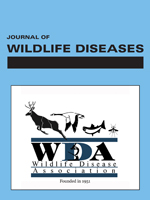The cloacal cestode Cloacotaenia megalops is one of the most common helminths of waterfowl. We investigated the effect of this parasite on the body condition of wintering waterfowl populations and compared prevalence among age-sex classes, over time and between habitat types on the upper Gulf Coast of Texas (USA) from October 1986–February 2000. Greater than 9,500 birds of 25 waterfowl species were examined for the parasite. There was no statistical difference (P>0.05) in body condition between birds with and without the parasite. Average prevalence was lowest for geese (x̄=3.7%) versus 21 to 71% in duck species. Average prevalence was similar (P=0.81) between diving ducks (x̄=46.9%) and puddle ducks (x̄=43.9%). Prevalence varied among age-sex classes and was related to sex rather than age. Variation among age-sex classes suggests differences in diet between sexes of duck species on the wintering grounds. There was no evidence for declining prevalence over the wintering period. Prevalence differed (P<0.05) between collection sites, and thereby habitat types, for several species. Temporal trends indicate stable prevalence of C. megalops for diving ducks and increasing prevalence for puddle ducks. The increasing trend for puddle ducks may indicate declining habitat conditions resulting in increased exposure to the intermediate ostracod host.
BioOne.org will be down briefly for maintenance on 17 December 2024 between 18:00-22:00 Pacific Time US. We apologize for any inconvenience.
How to translate text using browser tools
1 January 2003
SPATIAL AND TEMPORAL CHANGES IN PREVALENCE OF A CLOACAL CESTODE IN WINTERING WATERFOWL ALONG THE GULF COAST OF TEXAS
David A. Haukos,
Jim Neaville

Journal of Wildlife Diseases
Vol. 39 • No. 1
January 2003
Vol. 39 • No. 1
January 2003
Cestode
Cloacotaenia megalops
Cypris pubera
Gulf Coast
waterfowl




